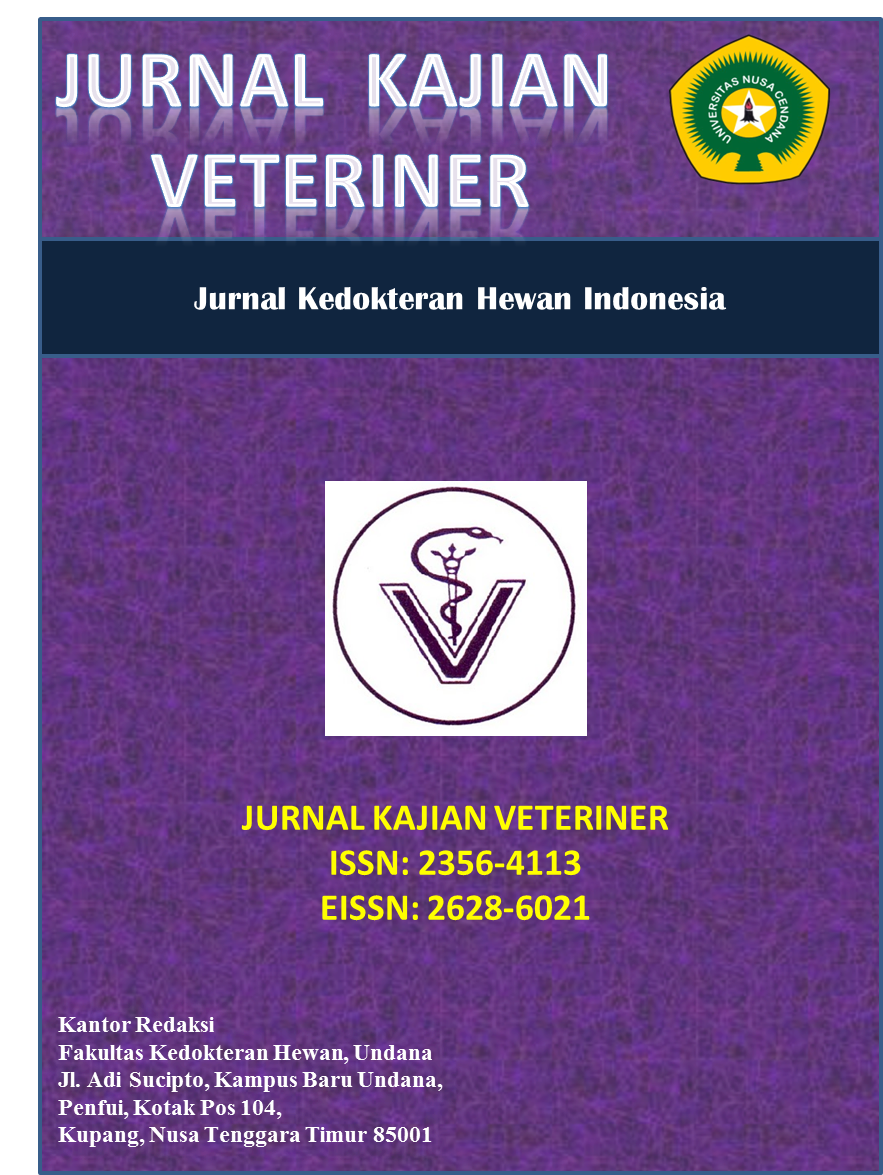KAJIAN PENGGUNAAN ANTIBIOTIK PADA PETERNAK BABI DI KABUPATEN ROTE NDAO
Antibiotic Use Study on pig Farmers in Rote Ndao Regency
Abstract
Pigs are livestock that are raised and bred for consumption and as a support for the community's economy. Rote Ndao Regency is one of the areas with a large pig population in NTT. Livestock health is an important factor to support the sustainability of pig farming in Rote Ndao, which cannot be separated from the use of antibiotics. Antibiotics are substances produced by microorganisms naturally, semi-synthetic or synthetic which in small amounts can inhibit or kill bacteria. However, the use of antibiotics by pig farmers is not done rationally. This can lead to antibiotic residues in food of animal origin, the incidence of resistance, and treatment failure. The purpose of this research is to examine the use of antibiotics by pig farmers without going through a prescription or veterinary supervision, the types of antibiotics often used by pig farmers and the reasons for using antibiotics themselves by pig farmers. Data were obtained from filling out questionnaires by 385 respondents as pig farmers. Primary data is processed and analyzed and then presented in the form of graphs or tables. The results showed that the respondents who used antibiotics without a prescription, applied antibiotics without the supervision of a veterinarian, were all pig farmers who used antibiotics. The most commonly used antibiotics are the tetracyclines, sulfonamides and penicillins. The reason pig farmers use antibiotics without veterinary supervision is that antibiotics are used to treat bacterial infectious diseases, increase livestock appetite, increase livestock weight, prevent disease and treat all types of diseases.
Downloads
References
Badan Pusat Statistika Kabupaten Rote Ndao. 2019, Kabupaten Rote Ndao Dalam Angka 2019, Nomor Publikasi 53140.1901. Rote Ndao, BPS Kabupaten Rote Ndao.
Ben Y, Fu C, Hu M, Liu L, Wong MH, Zheng C. 2019, Human health risk assessment of antibiotic resistance associated with antibiotic residues in the environment: A review. Environ Res 169: 483–493.
Elok, K., Bambang, R., dan Novita, D.K. 2019, Pengaruh Umur, Pendidikan, Kepemilikan Ternak Dan Lama Beternak terhadap Perilaku Pembuatan Mol Isi Rumen Sapi di Kut Lembu Sura. Jurnal Penyuluhan Pembangunan, 1(2): 1-49.
Etikaningrum dan Iwantoro. 2017, Kajian Residu Antibiotika Pada Produk Ternak Unggas Di Indonesia. Jurnal Ilmu Produksi dan Teknologi.
Kementerian Pertanian. 2017. Peraturan Menteri Pertanian Republik Indonesia, Nomor14/PERMENTAN/PK.350/5/2017, tentang Klasifikasi Obat Hewan, Jakarta, Biro Hukum Kementan RI.
Maryam, M B Paly, dan Astati. 2016, Analisis Faktor-Faktor yang Mempengaruhi Penentu Pendapatan Usaha Peternakan Sapi Potong (Studi Kasus Desa Otting Kabupaten Bone). Jurnal Ilmu dan Industri Peternakan 3(1): 79–101.
Purnawarman, T., dan Efendi, R. 2020, Pengetahuan, Sikap, dan Praktik Peternak dalam Penggunaan Antibiotik Pada Ayam Broiler di Kabupaten Subang. Acta VETERINARIA Indonesian, 8(3):48-55).
Copyright (c) 2022 JURNAL KAJIAN VETERINER

This work is licensed under a Creative Commons Attribution-NonCommercial-NoDerivatives 4.0 International License.

 Putri B. A. Panie(1*)
Putri B. A. Panie(1*)








.png)


